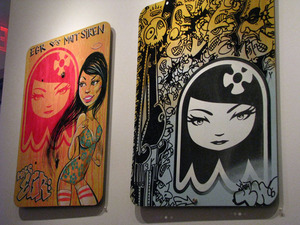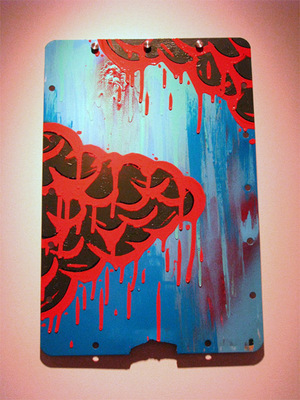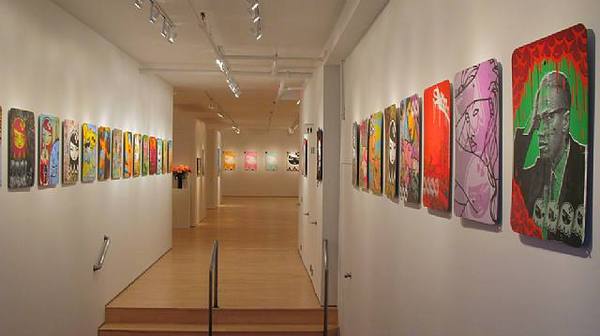This is an archive of the ArtCat Zine, 2007-2009. Please visit our new project, IDIOM.
Street Language and Sign Language at Woodward Gallery
Street Language
Darkcloud & Matt Siren
Woodward Gallery - 133 Eldridge Street New York, NY
May 10 - June 28, 2008
Sign Language
Woodward Gallery - 133 Eldridge Street New York, NY
May 10 - June 28, 2008
The two simultaneous shows at the Lower East Side's Woodward Gallery are a complicated affair. One tagged — pardon the pun — as Street Language is by two prominent New York street artists, Matt Siren and Darkcloud. The other, titled Sign language, greets visitors to the gallery before they proceed to the larger two-person show.
"Sign Language" is comprised of small metal signs created by a dream list of street art brands, including Phalllic Memory, Celso, Vor138, Keely, Deo, xinagrafx, AVone and 2esae. These "Untitled" mash-ups juggle various styles (or brands) to produce exciting, fun and engaging panels. When Matt Siren layers his thick lines over top of The Lovely Brenda's pin up girls, there's a dialogue — each panel is like a paragraph in a larger story. The street artists vie for attention like advertisers in the city.
If the individual pieces are interesting, the show does little more than try to blatantly market aspects of a scene that doesn't really thrive in a petri dish (or a conventional art gallery). This exhibition highlights the continuing problem street art faces as it responds to growing popularity and its practitioners try to cash in on their burgeoning fame. The show does little to address the urban lexicon and some of its volatile energy.
The gallery press release tries hard to establish a relevance for what we're seeing: "Connected through the rapid waves of text messaging, blogs, and websites these urban artists are now able to connect internationally with their peers creating a shifting social network. Their organized approach to a self-guided movement, so prominent in user-generated wiki-culture, is mirrored in each artist’s unique attempt to edit the urban landscape."
The problem is that removed from the city, these sanctioned works don't edit as much as decorate. Robbed of their "natural" context they look design-y. That's not to say they aren't good, but their success is in spite of the gallery context. The works themselves are small and suffer from the choke hold of their diminutive size.

The Siren's Call
After walking by the alley of mash-ups, the rest of the gallery is filled with pictures by the anime-influenced Matt Siren and the moody and painterly Darkcloud. Siren seems to dominate the show with his big serialized graphics, namely his iconic doe-eyed teen with mid-length black hair. The graphic is more 2001 than 2008, and evokes postcards, stickers, CD covers and websites graphic from almost a decade ago. The problem with street art brands, like their corporate kin, is that they don't lend themselves easily to change since recognition is part of the experience. This is coupled with the reality that in art, like advertising, brands can dilute their power with overzealous saturation.
Siren's large repetitious metal panels of his iconic girl are monotonous and have cutesy names like Blinky, Ghost Girl, Sue, Pinky and Inky (all 2008). Strangely the same is not true for the same images on paper, which adds a certain crispness and luminosity absent on the metal plates.
MSXPM (2007) is one of Siren's most successful prints and the original (I'm assuming) metal work is in the combo gallery at the front. Created with Phallic Memory, "MSXPM" is vibrant and visually draws you in with its strange configuration and off-center composition. Bold, mysterious and daring, the piece is everything I wish his other work could be. Other collaborative works, like "Quintsexual 1" and "Quintsexual 2" (both 2008) — created with The Lovely Brenda — are also more layered and complex than his solo pieces. The graphics are playful and collide disparate visual languages and in the process energize each.

Anything But Cloudy
Darkcloud is the poet laureate of the street artist set. He can't hide his painterly tendencies in his street work, which often consists of painted stickers that look like they were grafted from a larger composition. His outdoor work doesn't easily strike up a conversation with neighboring street art. His cloudy brand offers up a small patch of meditation in a sea of urbanity, like haikus on a newspaper page.
Among Darkcloud's contributions to the show is an early piece entitled, Before 1, Before 2 (diptych) (2004). This two part piece, composed of enamel on metal shelves, is telling for being the only work to address the gallery format directly. Here Darkcloud's iconography breaks apart and the comic strip style does not overwhelm but complements the visual exploration. He seems conscious that art in a gallery can riff off street art linguistics but must provide something different from illegal outdoor pieces. He is noticeably comfortably in the language of painting and seems to enjoy experimenting within its parameters.
Darkcloud's Whirlpool and No Left Turn (both 2008) explore new terrain and the latter's bent edge and impressionistic cloud — which breaks apart into a painterly haze — gives the work a sculptural flare. Sometimes the experimentation is more volatile, creating stunning results like Process Blue Landscape (2008) and Winter Landscape (2008), both of which distill a vibrant vision that transcends the street. The colors are appealing and the drawing expands on his usual lexicon. Both are painted on yield sign supports that, while recognizable, don't dominate the picture. The painting is well-suited to the forms.
Darkcloud seems at his best when he lets his clouds react to the mysterious atmospheric changes that pass through his overcast scenes. Even when the characteristic cotton ball clouds become turd-like in Faceless Blunder (2008) the effect is alchemical, creating new vistas that invigorate the imagination. He can at times overwork patches of his work, like the red Xs in "Faceless Blunder," which distracts from his compositions.
The only noticeable flaw in Darkcloud's art--something many (if not most) street artists that venture into the gallery scene also demonstrate — is that all the surfaces of his work remain uniformly slick and impenetrable. Only in his small piece Metal Sign – C (2008) does the paint seem to bubble and draw your attention to the paint's viscosity. I venture to guess that the street art world's reliance on Flickr and other web-centric modes of communications have made them oblivious to the role of surface, texture and other tactile aspects of art. In the gallery venue however, ignoring the lived experience of seeing can be death.
The gallery has also set up a blog in an obvious nod to the role the web plays as the mortar to a global scene that often produces ephemeral works. Unfortunately, the blog, which is not frequently updated and has no comments, comes across as a fashionable marketing tool rather than a legitimate attempt at plugging into the scene.
Street Language and Sign Language are the latest attempt by a New York gallery to market the volatile street art scene. The paired exhibitions offer insight into the direction this marriage of street and gallery may lead, namely harnessing the allure of an illegal activity into a tamer commercial setting. If this "art whispering" is to be successful, not only will the artists need to adapt but so will the galleries.
ZINE
HOME
TIPS / COMMENTS
CATEGORIES
CONTRIBUTORS
- Greg Afinogenov
- B. Blagojevic
- Adda Birnir
- Susannah Edelbaum
- Julie Fishkin
- Paddy Johnson
- Jessica Loudis
- Christopher Reiger
- Andrew Robinson
- Peter J. Russo
- Blythe Sheldon
- S.C.Squibb
- Hrag Vartanian

